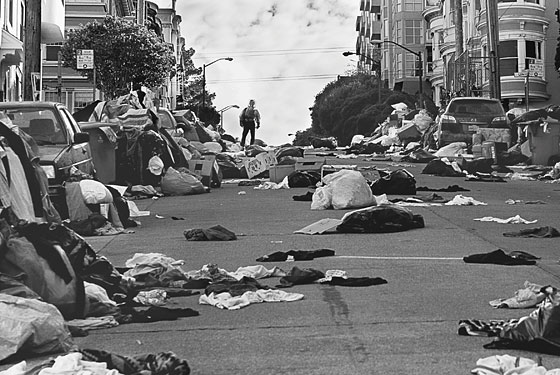
Movies have always flogged doomsday scenarios, from nuclear holocausts to zombie plagues to alien invasions, but the range and scale and utter conviction of this year’s apocalyptic visions are enough to make you stock up on canned goods and gas masks. That’s what Curtis (Michael Shannon), the hero of Jeff Nichols’s Take Shelter, does after nightmares and waking dreams of viscous black rain, funnel clouds, rabid pets, and marauding humans. The obvious conclusion is that Curtis has seen too many movies, except (spoiler!) he turns out (I said, spoiler!) to be (last warning!) prescient. No specific cause for the end of days is identified. It’s a Rorschach apocalypse.
In 2011, at least two other movies end with the end; another portends the doom of human society; and two more predict, at the very least, a civilization that will be lucky to recover. Not all these Armageddons are meant to be taken literally. The big bang provides a mischievous exclamation point for Gregg Araki’s gender-role-annihilating comedy Kaboom. On the other hand, Melancholia cuts a wider swath. It’s true that Lars von Trier’s drama, named for the disposition of the heroine (Kirsten Dunst) as well as the planet about to collide with our own, is the work of a cosmic solipsist who exults in the prospect of the outer world’s conforming to his malignant inner one. But the nihilistic bastard makes a vivid case that our planet—godless, loveless, corrupted by capitalism—is not worth preserving. You can picture him, like Boris Karloff’s Frankenstein Monster in The Bride of Frankenstein, lowering the boom while proclaiming, “We belong dead!”
The movies that leave us alive are, if anything, more disturbing. Contagion comes on like an old-fashioned disaster movie in which the big stars are dispatched with Irwin Allen–esque efficiency. But Steven Soderbergh’s thriller, in which millions are wiped out in mere weeks, is firmly grounded in the latest thinking about viruses and globalization. It’s no idle plot point that Patient Zero (Gwyneth Paltrow) works for a multinational company and jets from Hong Kong to Minneapolis by way of Chicago, infecting people (in fast montages of contact) on their way to all corners of the world. The virus’s origin might be random (“Somewhere in the world the wrong pig met up with the wrong bat,” explains a scientist, which would also account for the Kardashians), but capitalism facilitates the spread. People are even shown coughing on their money before handing it over. Does Big Pharma save the day? No, it’s a plucky female government researcher disobeying orders. But at least Big Pharma doesn’t develop the mankind-exterminating virus the way it does in The Rise of the Planet of the Apes, after performing a lot of nasty for-profit experiments on chimps. The audience cheers when the super-capitalist villain gets it so it hurts. Eat your hearts out, Occupy Wall Street.
The Wall Street villain was the biggest scapegoat in films of the thirties and forties, before World War II and the subsequent rise of the Red Menace, and he (or she, these days) is back with a vengeance—and now with the power to destroy the world. J. C. Chandor’s Margin Call isn’t a literal disaster film, but it’s shaped like one, from an underling’s inkling that the vast multinational investment firm is about to get hit by a financial meteor to the radical consultations with analysts and bigwigs on how to avert the conflagration. But in this case, the company saves itself by triggering worldwide financial chaos. Faced with the choice of swallowing hard and paying for their mistakes or hoodwinking and ruining thousands of investors (many of whom control the finances of thousands more investors), the characters all, from top to bottom, take the money. Let me say it again: They take the money.
What do they sell that triggers the economic apocalypse? Assets that are worthless, even illusory. One character in Margin Call likens the onrushing catastrophe not to a bad dream but to waking up from a good one. Which is, of course, what’s behind the doomsday-movie wave of 2011. We know our bubble is about to burst, that our artificial prosperity is corrupt and unsustainable. And even if somehow, somehow, the greedheads change their ways and the temperature of the Earth doesn’t rise and the polar ice caps don’t melt and oil remains plentiful enough to drive back and forth from our houses in the suburbs, we’ll still be haunted, like Curtis in Take Shelter, by the thought that something bad is about to go down. And we’ll seek out doomsday movies to see how it all plays out. The end of the world has barely begun.
